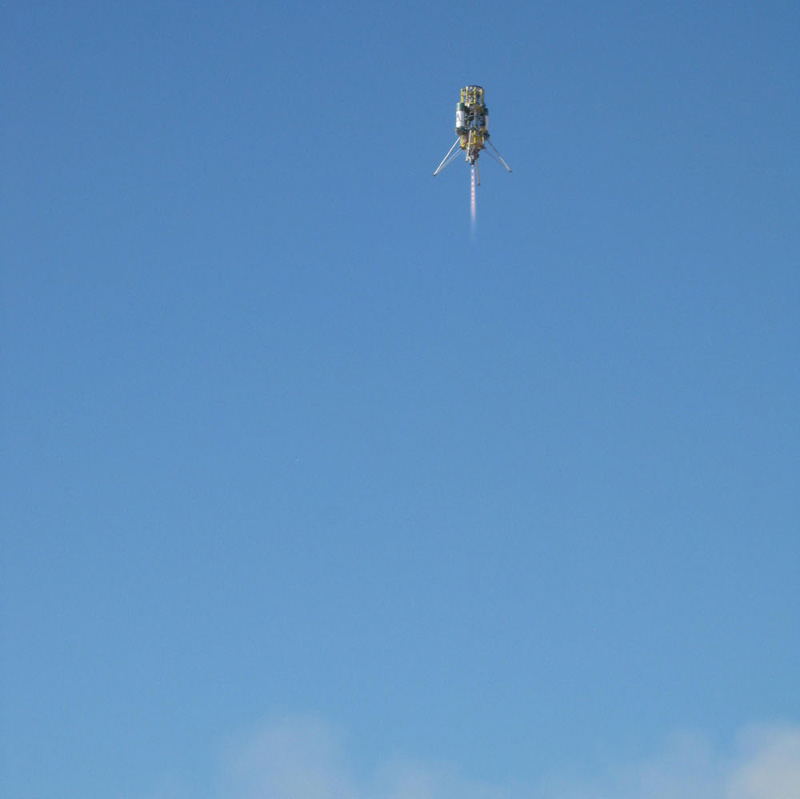Engine Leak Stalls Xombie Rocket’s Bid for NASA Cash

A privately-builtrocket nicknamed Xombie suffered an apparent engine leak Wednesday that stalledits attempt to win $150,000 in a NASA contest to fly mock moon landers.
Built byMasten Space Systems in Mojave, Calif., the Xombie rocket lifted off at the MojaveAir and Space Port and successfully flew to a nearbylanding pad, but failed to make the required return trip during a flightfor the Northrop Grumman Lunar Lander Challenge. A small leak detected in therocket?s engine chamber after landing was cited as the cause, contestorganizers said.
?There wassome wear that they were unhappy with on their regeneratively-cooled engine,?said Will Pomerantz, senior director of spaceprizes for the X Prize Foundation that manages the challenge for NASA. ?Itwas something where they did not feel comfortable flying again with the vehiclein that state.?
The LunarLander Challenge is part of NASA?s Centennial Challenges program to offer cashprizes for successful feats of engineering. For the Lunar Lander Challenge,NASA is offering a total of $2 million in prize money for successfulflight demonstrations of vehicles capable of hopping from one launch pad toanother.
The Mastenteam now hopes try again with its Xombie rocket - officially named XA-0.1B - duringone of two more chances in October. The Xombie rocket will have to start theround trip from scratch, despite making it halfway Wednesday and landing within8 inches (20 cm) of its target.
?They?ll beon a new clock,? Pomerantz told SPACE.com.
The Xombierocket?s next chance to fly is a two-day window that opens on Oct. 7. Therocket can make a third round of flights on Oct. 28 and 29, Pomerantz said.
Breaking space news, the latest updates on rocket launches, skywatching events and more!
Competitionheats up
In additionto Masten Space Systems, at least two other teams are competing in the Lunar LanderChallenge this year. The teams have until Oct. 31 to vie for the Level 1 andLevel 2 prizes. The third team - a father-son duo called Unreasonable Rocket -is slated to go last at the end of October in Cantil, Calif.
Level 1 ofthe competition, which Masten tried to qualify for Wednesday, requires vehiclesto fly for at least 90 seconds and fly a round trip between two differentlaunch pads. The team Armadillo Aerospace of Mesquite, Texas, wonthe $350,000 first prize for Level 1 in October 2008, leaving the $150,000second prize up for grabs.
Level 2requires competitors to fly vehicles on a roundtrip of at least 180 seconds in duration and land on a simulated lunar surface.First place awards $1 million, with $500,000 available for the runner-up.
OnSaturday, Armadillo Aerospace successfully qualified for the Level 2competition with its Scorpius lander that flew in Caddus Mills, Texas, nearDallas. If another team does not qualify for the Level 2 prize and land moreaccurately than Scorpius, Armadillo will take home first prize.
?It is nowguaranteed that we will definitely give away at least $1 million,? Pomerantzsaid.
Pomerantz saidthat since its inception the different teams competing in the Lunar LanderChallenge have collectively spent between $15 million and $20 million for the$2 million purse.
If anyprize money is not won during this year?s Lunar Lander Challenge, it will beavailable during one last competition in 2010 before expiring, he added.
- Video - Magic in the Mojave: NewSpace Visionaries
- Video - 2007 Lunar Lander Challenge Woes
- SPACE.com Video Show: X Prize in Space

Tariq is the award-winning Editor-in-Chief of Space.com and joined the team in 2001. He covers human spaceflight, as well as skywatching and entertainment. He became Space.com's Editor-in-Chief in 2019. Before joining Space.com, Tariq was a staff reporter for The Los Angeles Times covering education and city beats in La Habra, Fullerton and Huntington Beach. He's a recipient of the 2022 Harry Kolcum Award for excellence in space reporting and the 2025 Space Pioneer Award from the National Space Society. He is an Eagle Scout and Space Camp alum with journalism degrees from the USC and NYU. You can find Tariq at Space.com and as the co-host to the This Week In Space podcast on the TWiT network. To see his latest project, you can follow Tariq on Twitter @tariqjmalik.
